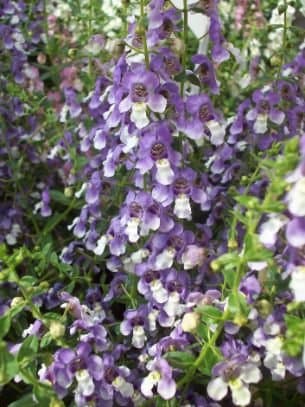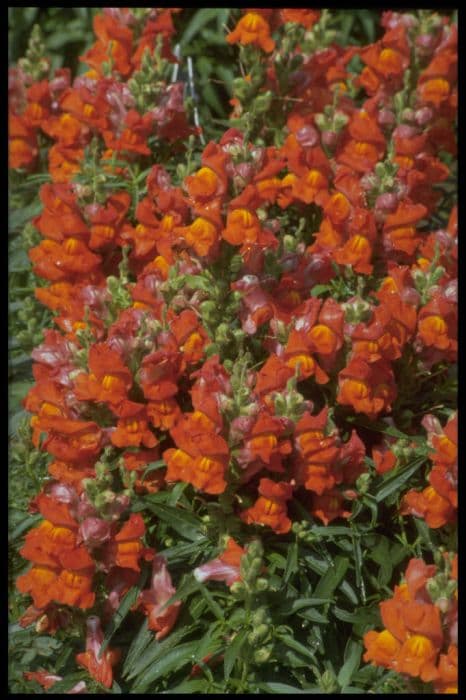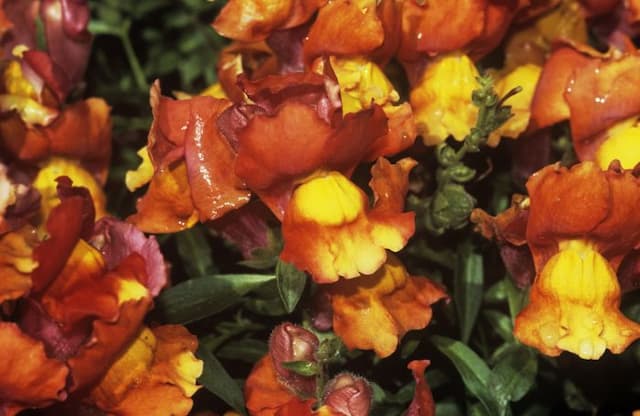Penstemon 'Music Maker' Penstemon 'Music Maker' (Elgar Series)

ABOUT
'Music Maker' is a semi-evergreen perennial to around 60cm tall with narrow mid-green leaves and bell-shaped pink flowers, eachwith a paler pink throat borne on upright stems from summer into early autumn
About this plant
 Names
NamesFamily
Plantaginaceae
Synonyms
Beard Tongue, Beardtongue
Common names
Penstemon 'Music Maker' (Elgar Series).
 Characteristics
CharacteristicsLife cycle
Perennials
Foliage type
Semi-deciduous
Color of leaves
Green
Flower color
Mixed
Height
1-2 feet (30-60 cm)
Spread
1-2 feet (30-60 cm)
Plant type
Herb
Hardiness zones
5
Native area
North America
Benefits
 General Benefits
General Benefits- Attractive blooms: Penstemon 'Music Maker' produces vibrant flowers that add color and visual interest to gardens.
- Drought tolerance: Once established, this plant is relatively drought-tolerant, requiring less frequent watering.
- Easy to care for: Penstemon 'Music Maker' is generally low-maintenance, making it suitable for beginner gardeners.
- Pollinator-friendly: The flowers attract bees, butterflies, and other beneficial pollinators, supporting local ecosystems.
- Long flowering period: It has a lengthy blooming season, providing garden color for an extended period.
- Versatility: Suitable for borders, rock gardens, and containers, offering various landscaping options.
- Cold hardy: It can withstand cold temperatures, making it suitable for gardens in cooler climates.
- Hummingbird attractant: The tubular flowers are particularly attractive to hummingbirds.
 Medical Properties
Medical PropertiesThis plant is not used for medical purposes.
 Air-purifying Qualities
Air-purifying QualitiesThis plant is not specifically known for air purifying qualities.
 Other Uses
Other Uses- Natural Dyes: Penstemon flowers can be used to produce natural dyes for fabrics and yarns, often resulting in subtle shades of color influenced by the specific variety of the plant.
- Photography Subject: With their striking blossoms, Penstemons provide an ideal subject for botanical photography, allowing photographers to capture the intricate details and vibrant colors of these flowers.
- Educational Tool: Penstemons can be used in educational settings, such as botanical gardens or schools, to teach about pollination and the importance of native plants in supporting local wildlife.
- Artistic Inspiration: Artists may use the diverse range of colors and shapes present in Penstemon flowers as inspiration for paintings, drawings, and other forms of visual art.
- Floral Arrangements: Fresh or dried Penstemon flowers can be incorporated into floral arrangements to add height and a touch of wild beauty.
- Culinary Garnish: The flowers of some Penstemon varieties may be edible and can be used as a decorative garnish for plates and desserts, although one should always verify edibility before consumption.
- Garden Theme Creation: Penstemon 'Music Maker' can contribute to a music-themed garden, where each plant is selected for its association with musical terms or famous composers, creating a harmonious landscape design.
- Companion Planting: Penstemons can be used in companion planting to attract pollinators to the garden, benefiting fruit and vegetable crops that depend on pollination for a successful yield.
- Seasonal Decor: The robust blooms and foliage of Penstemon can provide natural decoration for seasonal celebrations, particularly in outdoor settings.
- Signature Scent: Though not typically known for strong fragrances, the subtle scent of Penstemon can be infused into potpourri mixes to create a unique and understated aroma for indoor spaces.
Interesting Facts
 Feng Shui
Feng ShuiThe plant Penstemon is not used in Feng Shui practice.
 Zodiac Sign Compitability
Zodiac Sign CompitabilityThe plant Penstemon is not used in astrology practice.
 Plant Symbolism
Plant Symbolism- Harmony: Since Penstemon is part of the 'Music Maker' series, named after composer Edward Elgar, it symbolizes harmony, reflecting the musical association and the beauty of orchestrating balance in life.
- Endurance: Penstemons are known for their ability to withstand tough conditions, symbolizing resilience and the ability to endure and thrive in challenging circumstances.
- Attraction: With their bright, tubular flowers, Penstemons are known to attract pollinators, symbolizing allure and the power of attraction in both nature and personal endeavors.
- Diversity: As a genus with many varieties, Penstemons symbolize diversity and the beauty of variation, encouraging an appreciation for different qualities and forms.
 Water
WaterBeardtongue, including the Penstemon 'Music Maker', should be watered deeply once a week, ensuring that the soil is moist but not waterlogged. During the growing season, supplement with an additional half gallon per plant if the weather is particularly dry or hot. In cooler months or when rainfall is sufficient, reduce watering to every other week or when the top inch of soil feels dry to the touch. Be cautious not to overwater, as beardtongue is prone to root rot in soggy soil conditions.
 Light
LightBeardtongue thrives best in full sun where it can receive at least 6 to 8 hours of direct sunlight daily. A spot that provides morning light with some afternoon shade can also be suitable, but too much shade will result in fewer blooms and a leggy growth habit. Avoid deeply shaded areas to ensure the plant remains healthy and vibrant.
 Temperature
TemperatureBeardtongue is hardy and can withstand temperatures down to about 20 degrees Fahrenheit, but it prefers a range between 60 to 80 degrees for optimal growth. During extreme heat, make sure the plant has adequate moisture, and in areas with cold winters, provide mulch to protect the roots.
 Pruning
PruningPruning beardtongue is beneficial to promote bushier growth and more flowers. Deadhead spent blooms regularly throughout the blooming season to encourage continuous flowering. In late winter or early spring, cut back the plant to a few inches above the ground to allow for fresh growth and maintain a tidy appearance.
 Cleaning
CleaningAs needed
 Soil
SoilBeardtongue thrives in well-draining soil with a pH ranging from slightly acidic to neutral, between 5.8 and 7.0. The best soil mix for Beardtongue would be a combination of loam, coarse sand, and compost to ensure proper drainage and fertility. Adding perlite can further improve drainage, which is crucial to avoid root rot in these plants. Regular garden soil should be amended with these components to achieve the optimal growing medium for Penstemon 'Music Maker'.
 Repotting
RepottingBeardtongue does not require frequent repotting and can thrive in the same pot for several years. It is generally best to repot these plants every 2-3 years or when they become root-bound. During repotting, choose a container only one size larger than the previous one to prevent excessive moist soil, which can lead to root issues.
 Humidity & Misting
Humidity & MistingBeardtongue prefers moderate humidity levels but is tolerant of a wide range. It does not require high humidity to thrive and can acclimate to the average ambient humidity found in most outdoor garden settings. Ensure good air circulation around the plants to prevent any humidity-related issues.
 Suitable locations
Suitable locationsIndoor
Ensure abundant light and well-draining soil for indoor Beardtongue.
Outdoor
Plant in full sun with well-drained soil; water when dry.
Hardiness zone
4-9 USDA
 Life cycle
Life cyclePenstemon 'Music Maker' begins its life as a seed that, when sown in early spring, germinates to produce small, delicate seedlings. As temperatures warm, the seedlings develop into young plants exhibiting a rosette of leaves at the base. Throughout the growing season, the plant matures and sends up flowering stalks adorned with bell-shaped flowers that attract pollinators such as bees and hummingbirds. After pollination, the flowers fade, and seed capsules form which eventually dry and release seeds for the next generation. During the winter, the plant may die back, particularly in colder climates, but if it is a perennial variety, it may instead enter dormancy with its roots surviving underground. Come spring, the cycle begins anew, with the plant emerging once again to grow, flower, and set seed.
 Propogation
PropogationPropogation time
Spring to Early Summer
Propogation: The most popular method of propagation for the Penstemon 'Music Maker', which is part of the Elgar Series, is through stem cuttings. This technique is typically done in late spring or early summer when the plant is actively growing. You would start by selecting a healthy stem with new growth and cut a portion of about 4 to 6 inches (approximately 10 to 15 centimeters) in length. It is important to make the cut just below a leaf node, as this is where roots are most likely to form. The lower leaves should be removed from the cutting, and the cut end can be dipped in rooting hormone to encourage root development. The cutting should then be placed in a pot with moist potting soil, and it is crucial to maintain a humid environment by covering the pot with a plastic bag or placing it in a propagation chamber. In a few weeks, the cutting should develop roots and can eventually be transplanted to a larger pot or directly into the garden.









